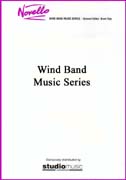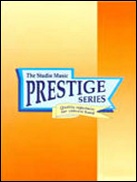Results
-
 £76.00
£76.00HARLEQUIN (Broughton) (Concert Band) - Broughton, Bruce
Harlequin is the most popular of the comic servant characters from the Italian commedia dell'arte who, although a slow thinker, was acrobatic and nimble - he would never perform a simple action when the addition of a cartwheel or backflip would spice up the movement! The characteristics are aptly portrayed musically in Bruce Broughton's mini concert overture. Originally published for brass band in 1984, this revised version for wind band conveys all the hustle, bustle, and agility of the character in a finely crafted musical structure. Ideal as a concert opener or encore, it is sure to delight audiences and provide players with an exciting new addition to their repertoire. Duration: 3:00 American Grade 4+
Estimated dispatch 7-14 working days
-
 £109.99
£109.99Il Briccone (Concert Band - Score and Parts)
A wind music federation from Upper Austria commissioned Thomas Doss to compose Il Briccone, the Italian word for scoundrel. It is an elegant concert march which combines light ironic elements with virtuosity and exciting rhythms. Its alternation between chamber music-like passages with figures from solo instruments combined with surprising stylistic changes keeps everybody's interest. This march is sure to be a great crowd pleaser. 06:15
Estimated dispatch 7-14 working days
-
 £94.99
£94.99Il Matrimonio Wind Band Set (Score & Parts)
Timothy Travis composed this wedding march for a relative. This march in an Italian format brings the warmth of a southern European wedding party (matrimonio) within reach. 03:30
Estimated dispatch 7-14 working days
-
 £139.99
£139.99Le Carnaval Romain (Wind Band Score & Parts)
Berlioz based his sparkling overture Le Carnaval Romain on themesfrom his opera Benvenuto Cellini. The opera had been performed a fewtimes in Paris, a number of years before, with little success. The overturehowever, quickly became very popular and is still today a great a crowdpleaser. The energetic vitality of the work - with an Italian touch- is certainly present in this skilfully written transcription by TohruTakahashi. 0:08:14
Estimated dispatch 7-14 working days
-
 £84.99
£84.99Mah Na, Mah Na (Concert Band - Score and Parts) - Umiliani, Piero - Schwalgin, Stefan
The Italian film music composer Piero Umiliani originally composed Mah Na Mah Na in 1968 for the soundtrack of the Swedish movie Sweden - Heaven or Hell. However the piece only became a hit in the 1970s, when Jim Henson used the catchy melody in his children's TV series The Muppet Show and Sesame Street. Stefan Schwalgin has produced this excellent version to give baritone saxophonists, who sometimes feel left out by the band's repertoire, a platform for their soloistic development. This gem is full of little musical surprises and will hold a special place in your bands repertoire. 03:45
Estimated dispatch 7-14 working days
-
 £164.95
£164.95OMAGGIO (Novello Symphonic) - Ball, Michael
Score & Parts. Omaggio is a homage to Italy and all things Italian. A brief Burla of a fast-moving scherzo character pays tribute to Verdi. Barcarola is sterner stuff - a grim black gondola evokes the Venice of the Serenissima. The movement is an actual gondola song coupled with the jaunty fanfares of Monteverdi and Gabrieli's Sonata pian'e forte. The most substantial movement is the final Palio, an unashamedly programmatic evocation of the historic Sienese horse-race, ending with a Tuscan folk-song. Duration: 16-18 mins
Estimated dispatch 7-14 working days
-
 £32.95
£32.95OMAGGIO (Novello Symphonic) Extra Score - Ball, Michael
Extra Score. Omaggio is a homage to Italy and all things Italian. A brief Burla of a fast-moving scherzo character pays tribute to Verdi. Barcarola is sterner stuff - a grim black gondola evokes the Venice of the Serenissima. The movement is an actual gondola song coupled with the jaunty fanfares of Monteverdi and Gabrieli's Sonata pian'e forte. The most substantial movement is the final Palio, an unashamedly programmatic evocation of the historic Sienese horse-race, ending with a Tuscan folk-song. Duration: 16-18 mins
Estimated dispatch 7-14 working days
-
 £71.28
£71.28Pagliacci - Leoncavallo, Ruggero
This gorgeous orchestral intermezzo from the famous opera "Pagliacci" has been masterfully scored for concert band by Andrew Glover. Soaring, passionate lines bring the essence of Italian "verismo" operatic style to the band with this emotional and lyrical selection. Dramatic and richly scored, this work will enthrall your audiences and performers as well. Magnifico!
Estimated dispatch 7-14 working days
-
 £18.95
£18.95PRINCIPIO (Prestige Concert Band Extra Score) - Wiffin, Rob
Extra Score. Principio means start or beginning in both Spanish and Italian and this piece is just that - an energetic concert opener! Duration: 4:30. Recorded on Polyphonic QPRM160D Bells Across the Atlantic.
Estimated dispatch 7-14 working days
-
 £94.95
£94.95PRINCIPIO (Prestige Concert Band Set) - Wiffin, Rob
Score and Parts. Principio means start or beginning in both Spanish and Italian and this piece is just that - an energetic concert opener! Duration: 4:30. Recorded on Polyphonic QPRM160D Bells Across the Atlantic.
Estimated dispatch 7-14 working days
